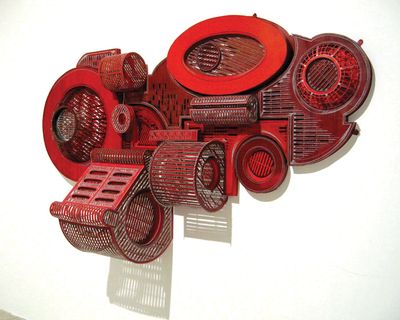Fractured: Works on Paper

Jane South, Untitled (Irregular Ellipse), 2008, hand-cut and folded paper, ink, acrylic, balsa wood, 96 x 54 x 24″.
Eleven artists transform the Helen Day Art Center in Fractured: Works on Paper, each one triumphing over space through optics, narrative, architecture, and light. All the work is riveting and highly detailed in its execution. It’s as if paper—the unifying medium here—requires nothing less than technical perfection. Curator Rachel Moore gives the works sufficient room to fully charge the atmosphere.
Inside the entrance, Joan Grubin’s work ripples with color and reflected light, quietly seducing viewers closer for an intimate view. Nearby, Kazue Taguchi’s Ilhabela uses swirling garlands of mylar and color cellophane to drape the space, filling a small room.
In Fractured, Moore has chosen works that splinter expectations and rupture the senses. Seeing is not believing and Jane South’s work confirms that, resoundingly. Two of South’s 3D assemblages (hand-cut and folded paper, ink, acrylic, and balsa wood) create optical illusions while calling to mind specific, sometimes opposing, imagery. Fans, windows, cylinders, and automotive parts can be seen or imagined in the red wall-mounted sculpture Untitled (Irregular Ellipse). Untitled (NC Yellow) suggests farm equipment, a Victorian train station or botanical garden.
South provides no sense of direction or point of view, further dismantling perspective. South’s Excerpt (an arrangement in black, white, and grey) is a much larger free-form assemblage, also of paper and balsa wood, but lights and electrical wires add to the sense of a radio station, music stage or boom box graveyard.
In an exhibit of strong contenders like Sarah Amos, Leonardo Drew, Olafur Eliasson, and Kiki Smith, Etty Yaniv is a standout. Yaniv’s At that moment all spaces change is a horizontal river of paper, undulating across a wall. Ripped from magazines, notebooks, old art works of Yaniv’s, photographs, and ephemera, the paper hints at a personal narrative and seems poised to churn up memories, leaving them in its wake. Its black and white and shifting shades of grey alternate from a storm of paper into a tsunami of ideas and whispered histories.
Dawn Clements’ drawings take up the entire width of two walls. The full-scale drawings (ballpoint pen ink on paper) provide a peek into bedrooms and drawing rooms. Mysterious hand-written notes offer a fuller narrative into her world on paper.
Fractured by 11 individualistic interpretations, the exhibition is entirely splendid.
